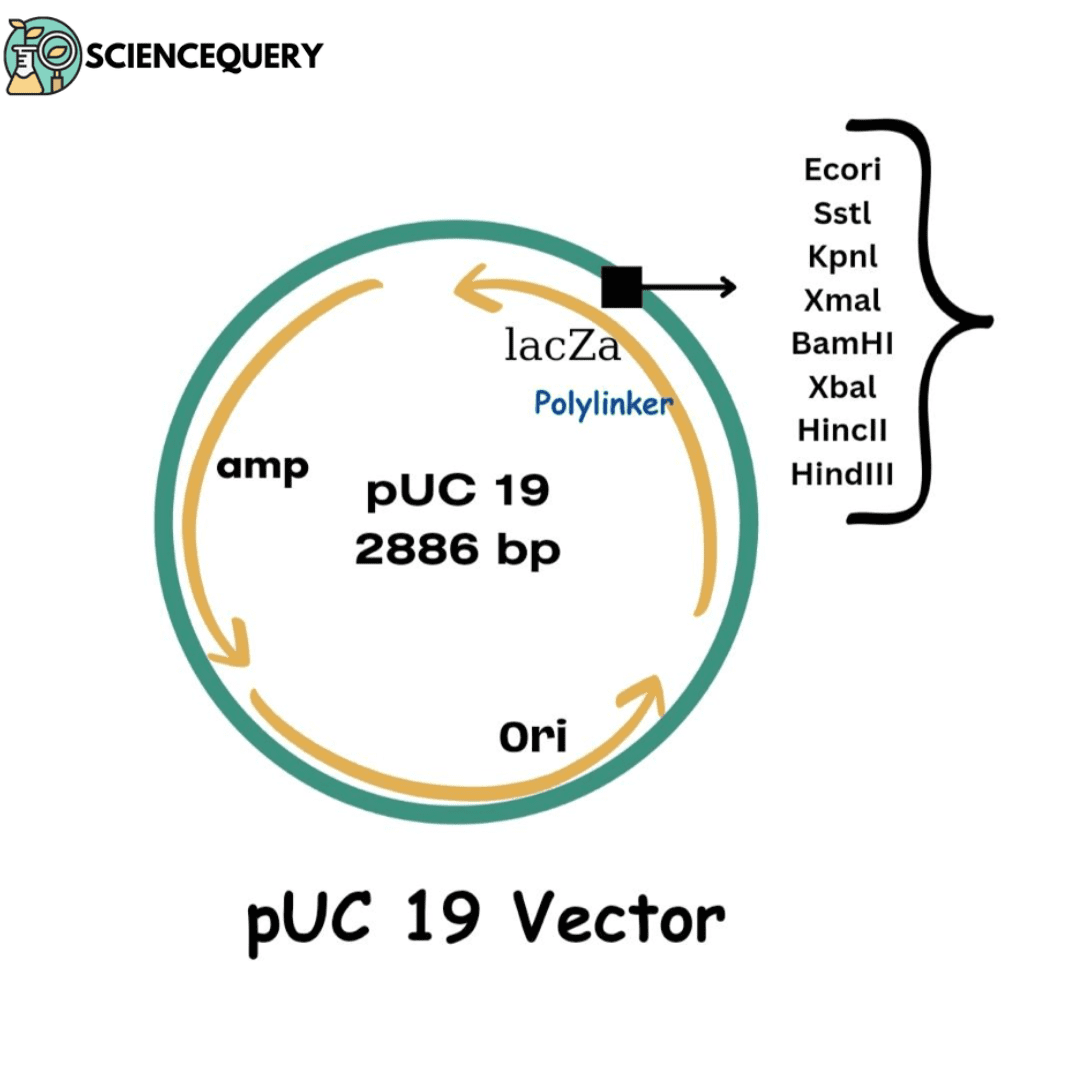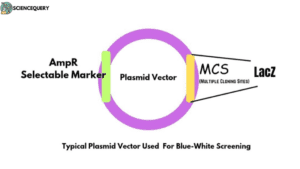
Introduction
Vectors and their importance
Vectors are the major component required to make an rDNA molecule for gene cloning. They act as a vehicle for carrying foreign DNA into a host cell for multiplication. Generally, small circular-shaped DNA molecules of bacterial origin are used as cloning vectors.
About pUC19 Vector
pUC 19 vectors belong to a class of plasmid vectors, extensively used in molecular biology research. They are highly popular due to their versatility and ease of operation. They are extensively used as cloning as well as expression vectors, thus making them an essential tool for many researchers.
pUC 19 vector was first formulated by J. Messing at the University of California, San Francisco in the early 1980s. They are small circular DNA molecules ranging from 2686-2693 base pairs (bp) in length.
The specialty of this particular vector is that it contains several features including a multiple cloning site (MCS). This enables easy insertion of foreign DNA molecular fragments, as well as antibiotic resistance genes like ampicillin or kanamycin.
Due to their small size and versatile features, pUC 19 vectors are used for various applications like gene cloning, protein expression studies, and mutagenesis experiments.
Structure
Origin
The PUC19 vector is a commonly used plasmid in molecular biology research. It was first developed by Messing and colleagues in 1982, making it one of the earliest vectors to be created for cloning purposes. The origin of the PUC19 vector can be traced back to its parent plasmid, pBR322.
This plasmid was widely used in genetic engineering experiments because of its small size and generation of high copy number (around 15-20 copies per cell). The high copy number mutations produce 500 to 600 copies of the plasmid per cell within the origin of replication. This whole process is carried out without any sort of amplification.
Limitations of pBR322 introduced the production of pUC series vectors. pUC19 is derived from pBR322 and pUC 18 vectors by the process of genetic engineering techniques.
Multiplication sites
There are potential replication sites, enabling them to replicate within the bacterial cells. These include mini-F replicon sequences like repE and repFIB from Escherichia coli F factor plasmids. ColE1sequences like oriR6K are derived from Klebsiella pneumoniae R6K plasmids.
Restriction sites
Restriction sites are also known as restriction endonuclease recognition sites. These sites generally help in the precise manipulation of DNA molecules in genetic engineering techniques. Common restriction sites found on puc19 include EcoRI, HindIII, BamHI, XbaI, and SalI. These restriction sites are placed accordingly within puc19 to allow for efficient cloning and insertion of desired genes.
Selectable markers
Selectable markers enable scientists to create GMOs with desirable traits such as resistance to pests or diseases. This particular plasmid shows a similarity with pBR322 and contains a gene called ampicillin resistance gene. It works as a marker and helps in screening the recombinants.
Sites
pUC 19 plasmid is highly used in molecular biology research. This plasmid contains several restriction sites that are useful for cloning experiments. EcoRI, BamHI, HindIII, XbaI, and PstI are some of the restriction sites. For example- BamHI recognizes the sequence GGATCC and cuts between G nucleotides. It can be found at positions 6 and 270 on the pUC 19 map.
Screening
The screening of pUC 19 plasmid is an important process in molecular biology research. It involves the identification and selection of bacterial colonies within the pUC 19 plasmid. There are several techniques for screening pUC 19 plasmids including:
Blue-White Screening

Blue-white screening in pUC19 is a commonly used technique in molecular biology for the identification and selection of recombinant plasmids. This process works by utilizing an enzyme called beta-galactosidase which can cleave a substrate called X-Gal into a blue product. The pUC19 vector contains the lacZ gene that encodes for this enzyme, but it also has a multiple cloning site within its coding sequence.
PCR Amplification
PCR refers to polymerase chain reaction. It amplifies DNA sequences within the pUC19 plasmid. The PCR process is used as it provides accurate results with negligible errors and is a highly efficient technique as well as cost-effective.
Restriction Enzyme Digestion
Restriction enzymes cut DNA at specific recognition sites, thus allowing researchers to analyze and manipulate genetic material. The screening of pUC19 has increased due to its efficiency and accuracy.
Applications
- Cloning: The pUC19 plasmid is used to clone DNA fragments of interest and then introduce them into the host cells.
- Transformation studies: The presence of an ampicillin resistance gene is useful in transformation studies by researchers.
- Protein production: Multiple cloning sites present on the pUC19 plasmid allow easy insertion of genes encoding proteins. It thus proves effective in protein production experiments.
- Mutagenesis studies: The MCS also makes this plasmid suitable for mutagenesis studies where specific mutations can be introduced into a gene sequence.
- Sequencing of Gene: Because of its small size and high copy number, the pUC19 plasmid proves ideal for use in DNA sequencing reactions.
- Antibiotic Resistance Marker Testing: Researchers utilize different antibiotic resistance markers by inserting them into the MCS of the pUC19 plasmid. Then they observe their effects on bacterial growth under suitable conditions.
Q&A
1. What is the pUC19 vector?
pUC 19 vectors belong to a class of plasmid vectors that are mostly used in molecular biology research.
2. What makes pUC19 a good cloning vector?
This plasmid was widely used in genetic engineering experiments because of its small size and generation of high copy number
3. What is the difference between pUC19 and pUC18 plasmid?
The ori for pUC 18 is derived from ColE1 whereas pUC 19 is derived from f1 bacteriophage. However, pUC 18 and pUC 19 plasmids are two commonly used cloning vectors in molecular biology.
4. What is the function of pUC in plasmid?
PUCs are small, circular pieces of DNA that can replicate independently from the host cell’s genome.
Summary
- pUC 19 vector belongs to a class of plasmid vectors, extensively used in molecular biology research.
- Vectors are the major component required to make an rDNA molecule for gene cloning.
- They act as a vehicle for carrying foreign DNA into a host cell for multiplication.
- Generally, small circular-shaped DNA molecules of bacterial origin are used as cloning vectors.
- It was first developed by Messing and colleagues in 1982, making it one of the earliest vectors to be created for cloning purposes.
- The origin of the PUC19 vector can be traced back to its parent plasmid, pBR322.
- This plasmid was widely used in genetic engineering experiments because of its small size and generation of high copy number (around 15-20 copies per cell).
- EcoRI, BamHI, HindIII, XbaI, and PstI are some of the restriction sites.
- These restriction sites are placed accordingly within puc19 to allow for efficient cloning and insertion of desired genes.
- The screening of pUC 19 plasmid is an important process in molecular biology research. It involves the identification and selection of bacterial colonies within the pUC 19 plasmid.
- The PCR process is used as screening; it provides accurate results with negligible errors and is a highly efficient technique as well as cost-effective.
- Because of its small size and high copy number, the pUC19 plasmid proves ideal for use in DNA sequencing reactions.
References
- https://www.microbiology.ubc.ca/sites/default/files/roles/drupal_ungrad/JEMI/4/4-51.pdf
- https://www.sciencedirect.com/science/article/pii/037811199090147J
- https://www.sciencedirect.com/science/article/pii/0378111987903659
- https://link.springer.com/chapter/10.1007/b12440
- https://www.sciencedirect.com/science/article/pii/0378111991900165
- https://www.sciencedirect.com/science/article/pii/S0968089699001467
- https://www.cabdirect.org/cabdirect/abstract/20103342793
Written By: Sushmita Mukhopadhyay
